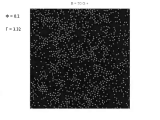Abstract:
A two-dimensional system
of particles with tunable repulsive interactions is
experimentally investigated. Soft ferromagnetic particles are
placed on a vibrating rough plate and vertically confined, so
that they perform a horizontal Brownian motion in a cell. When
immersed in an external vertical magnetic field, the particles
become magnetised and thus interact according to a dipolar
repulsive law. As the amplitude of the magnetic field is
increased, magnetic repulsion raises and the rate of inelastic
collisions decreases. Studying the pair correlation function and
the particle velocity distributions, we show that the typical
properties of such a dissipative out-of-equilibrium granular gas
are progressively lost, to approach those expected for a usual
gas at thermodynamic equilibrium. For stronger interaction
strengths, the system gradually solidifies towards a hexagonal
crystal. This new setup could consequently be used as a model
experimental system for out-of-equilibrium statistical physics,
in which the distance to the quasi-elastic limit can be
accurately controlled.


Movie 2. (2.7 MB M4V)
"Dissipative" regime (all parameters fixed). The particle area
fraction equals 0.2, the dimensionless acceleration equals 3.32,
and the magnetic field is off. (Movie slowed down 30x)

Movie 3. (2.7 MB M4V)
"Quasi-elastic" regime (all parameters fixed). The particle area
fraction equals 0.2, the dimensionless acceleration equals 3.32,
and the magnetic field equals 88 G. (Movie slowed down 30x)

Movie 4. (2.6 MB M4V) "Crystal"
regime (all parameters fixed). The particle area fraction equals
0.2, the dimensionless acceleration equals 3.32, and the magnetic
field equals 208 G. (Movie slowed down 30x)